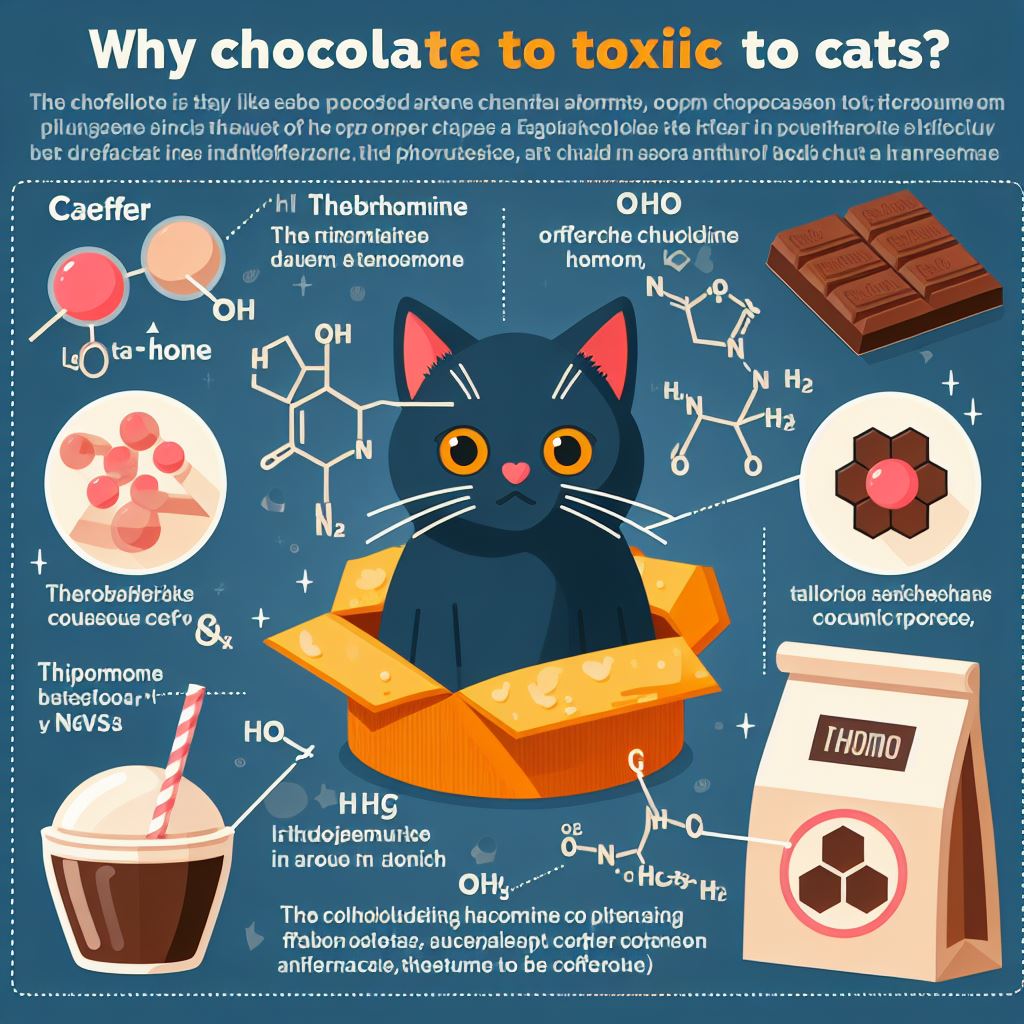Finding out your cat has eaten chocolate can be an incredibly stressful and scary experience for any pet owner. After all, chocolate is toxic to cats and can cause severe illness and even death if not treated promptly. But try not to panic – with quick action, your feline friend can make a full recovery.
This comprehensive guide will walk you through exactly what to do if your cat gets into your chocolate stash. We’ll cover:
- Why chocolate is dangerous for cats
- Assessing how much was ingested
- Inducing vomiting safely
- Getting emergency vet care
- Providing at-home supportive care
- Preventing chocolate poisoning in the future
Follow these tips and your furry companion will be back to their usual mischievous selves in no time.
Why Is Chocolate Toxic for Cats?

First, let’s look at why chocolate can be so harmful to kitties.
Chocolate contains two stimulant compounds that cats have difficulty metabolizing:
- Theobromine – This mild stimulant is found in all types of chocolate. Dark chocolate contains the highest levels of theobromine.
- Caffeine – Most chocolate contains small amounts of caffeine as well. Baking chocolate has the highest caffeine content.
Cats cannot effectively metabolize and excrete these two substances like humans can. Theobromine has a very long half-life in cats, remaining in the bloodstream and building up to toxic levels.
Even small ingestions of chocolate can cause:
- Vomiting
- Diarrhea
- Restlessness
- Rapid breathing
- Increased thirst and urination
- Elevated heart rate and blood pressure
Larger ingestions may lead to:
- Abnormal heart rhythm
- Muscle tremors and seizures
- Internal bleeding
- Heart attacks
- Coma
- Death
The higher the cocoa content of the chocolate, the more dangerous it is for cats. But even milk chocolate can be toxic in large enough amounts.
Tip: The darker and more bitter the chocolate, the higher the theobromine and caffeine levels. This makes dark chocolate and baking cocoa especially hazardous.
Assessing How Much Chocolate Was Eaten
If you catch your cat in the act of licking up some chocolate or find telltale wrappers, the next step is to immediately assess approximately how much was ingested.
Look for signs of eaten chocolate like:
- Open candy bars or bags
- Licked chocolate residue on whiskers or paws
- Chewed-up candy wrappers
- Missing chocolate chips or baking bits
Check the trash for discarded packaging to get an idea of the chocolate’s size and cocoa concentration. Bring the label and any remaining chocolate with you to the vet.
The more chocolate eaten, the higher the risk of toxicity, so an accurate estimate of the amount will guide your next steps.
Tip: Take pictures of the scene, chocolate evidence, and any labels or packaging to show your vet.
Call Your Vet
Regardless of the estimated amount ingested, you should call your vet or emergency vet clinic right away.
Describe what happened and details about the chocolate type and amount. They will help assess your cat’s risk level and whether inducing vomiting is advised or if immediate emergency care is needed.
You know your cat best. Also, note any pre-existing health conditions that could make them more vulnerable to chocolate’s effects.
Inducing Vomiting Safely
If it’s been less than 2 hours since ingestion, your vet may advise you to induce vomiting at home. This gets unabsorbed chocolate out of the stomach before it can get into the bloodstream.
However, never induce vomiting if your cat is:
- Unconscious
- Having seizures or convulsions
- Already tried vomiting but nothing came up
These require emergency vet treatment, not vomiting induction.
To make a cat vomit, hydrogen peroxide works well. Use the 3% solution found in most medicine cabinets.
Follow These Steps:
- Calculate the proper hydrogen peroxide dose for your cat’s weight. The dosage is 1 teaspoon per 5 pounds of body weight.
- Use an oral syringe or turkey baster to administer the hydrogen peroxide dose into your cat’s mouth.
- Rub their throat gently to stimulate swallowing.
- Expect vomiting to occur within 10-15 minutes.
- Rush them to the vet immediately after vomiting. Further treatment will likely be needed.
Tip: Never induce vomiting with salty substances like salt water or baking soda. This forces a cat to drink water, risking further chocolate absorption. Stick with hydrogen peroxide specifically.
Getting Emergency Veterinary Treatment
In situations where:
- It’s been over 2 hours since chocolate was eaten
- Large amounts were ingested
- Your cat is displaying symptoms already
Skip the vomiting induction and bring them to the vet or emergency animal hospital right away.
Note any symptoms you observe like:
- Vomiting or gagging
- Diarrhea
- Restlessness or hyperactivity
- Fast, irregular breathing
- Excessive thirst or urination
- Muscle spasms or twitching
The vet will examine your cat and ask questions to determine the severity of toxicity. Provide details on the chocolate type, estimated amount eaten, packaging labels, and any symptoms observed.
Treatments the vet may provide include:
- Inducing vomiting – If it’s still within the 2-hour window. This is safer at the clinic.
- Activated charcoal – This oral supplement binds to the toxins in chocolate, preventing absorption into the bloodstream.
- IV fluids – Fluids help flush out the kidneys and prevent dehydration from vomiting and diarrhea.
- Medications – Anti-seizure medicines treat muscle tremors and convulsions from chocolate’s stimulants.
- Bloodwork – Tests show the level of toxins present and whether internal organs have been damaged.
- ECG monitoring – Heart rate and rhythm are tracked, as stimulants can cause rapid, irregular heartbeat.
- Oxygen therapy – Oxygen is administered if breathing is impaired.
- Hospitalization – For several days if the cat is comatose or requires intensive treatment.
With aggressive veterinary therapy, the prognosis for chocolate poisoning is very good in most cases. The sooner treatment begins, the better the outcome.
Tip: Never wait “to see what happens” after chocolate ingestion. Act immediately, as toxicity can escalate rapidly.
Providing At-Home Supportive Care
Once your cat is back home after treatment, follow your vet’s care instructions closely to help them continue recovering. Typical recommendations include:
Monitoring for delayed symptoms – Look for vomiting, diarrhea, increased thirst, agitation, muscle twitches, or abnormal behaviors over the next 24 hours. Call your vet if you observe anything abnormal.
Medicating as directed – Give all medications exactly as prescribed. Common meds include anti-nausea, digestive aids, and anti-seizure medicines.
Encouraging rest – Restrict activity to allow plenty of sleep and relaxation. Handle gently and minimize stress during the recovery period.
Keeping hydrated – Provide easy access to fresh, clean water. Consider adding low-sodium chicken broth to increase palatability if your cat isn’t drinking normally.
Feeding gastrointestinal food – Feed a bland diet like boiled chicken and rice for a few days. Then transition back to your cat’s regular food.
Avoiding fatty foods – Steer clear of fatty ingredients until digestion regulates. Stick with light, lean proteins.
Watching the litterbox – Note any ongoing diarrhea or straining. Call your vet if abnormalities persist beyond 24 hours.
With attentive home nursing care, your cat should make a full recovery within a couple of days. Relapses are unlikely but stay vigilant for delayed onset of symptoms.
Preventing Chocolate Poisoning
Once your cat is back to full health, keep these tips in mind to prevent any repeat chocolate catastrophes:
- Keep all chocolate safely tucked away in cabinets or containers. Cats can be adept candy thieves.
- Don’t underestimate their ability to get into things. Use child locks, pet gates, and high shelves to restrict access.
- Never leave unattended chocolate out on counters or low tables. Not even for a minute!
- Properly dispose of wrappers, bags, and boxes so they aren’t tempting playthings. Tie trash bags securely shut.
- Avoid baking or melting chocolate when your cat is underfoot. The smell can draw them in.
- Make chocolate goodies inaccessible, even during cooling phases. Shut doors to keep cats out of kitchens.
- Educate kids not to share candies, cookies, or hot cocoa with feline friends. Children often don’t know better!
- Opt for pet-safe treats instead of chocolate indulgences when rewarding or celebrating your pet.
Stay vigilant year-round, as chocolate accessibility spikes around holidays like Halloween, Christmas, Valentine’s Day, and Easter. Just a few preventative steps can keep your cat safe from chocolate’s harm.
The Outlook is Sweet When You Act Fast
While certainly scary at the moment, the prognosis for chocolate poisoning in cats is actually quite positive in most cases. With prompt veterinary treatment, even large ingestions can be managed successfully.
The key is taking immediate action by:
- Estimating the amount eaten
- Inducing vomiting if advised
- Getting emergency vet care right away
- Providing supportive at-home care
Monitor your recovering cat closely in the days following treatment. Avoid fatty foods during the digestive recovery period.
Then take proactive steps to prevent any repeat chocolate exposures. Your furry friend will be back to their usual mischievous self in no time.
With vigilance and care, you can help ensure your cat lives a long, happy, and chocolate-free life!




